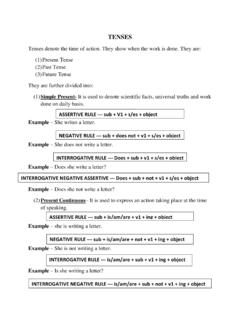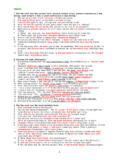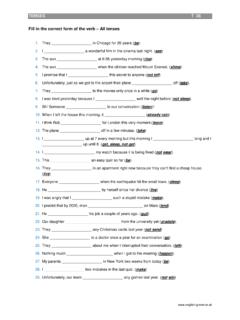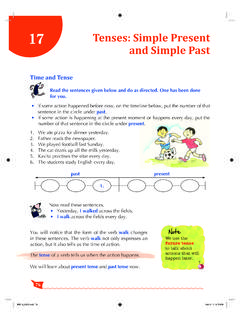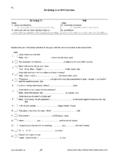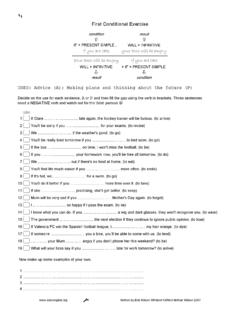Transcription of TENSES - laps.in
1 TENSES TENSES denote the time of action. They show when the work is done. They are: (1) Present Tense (2) Past Tense (3) Future Tense They are further divided into: (1) Simple Present- It is used to denote scientific facts, universal truths and work done on daily basis. Example She writes a letter. Example She does not write a letter. Example Does she write a letter? Example Does she not write a letter? (2) Present Continuous It is used to express an action taking place at the time of speaking. Example she is writing a letter.
2 Example She is not writing a letter. Example Is she writing a letter? ASSERTIVE RULE --- sub + V1 + s/es + object NEGATIVE RULE --- sub + does not + v1 + s/es + object INTERROGATIVE RULE --- Does + sub + v1 + s/es + object INTERROGATIVE NEGATIVE ASSERTIVE --- Does + sub + not + v1 + s/es + object =+ ASSERTIVE RULE --- sub + is/am/are + v1 + ing + object NEGATIVE RULE --- sub + is/am/are + not + v1 + ing + object INTERROGATIVE RULE --- is/am/are + sub + v1 + ing + object INTERROGATIVE NEGATIVE RULE --- is/am/are + sub + not + v1 + ing + object Example Is she not writing a letter?
3 (3) Present Perfect It is used to show an action that started in the past and has just finished. Example- She has written a letter. Example She has not written a letter. Example- Has she written a letter? Example Has she not written a letter? (4) Present Perfect Continuous This tense shows the action which started in the past and is still continuing. Example She has been writing a letter. Example She has not been writing a letter. Example Has she been writing a letter? Example Has she not been writing a letter? ASSERTIVE RULE --- sub + has/have + v3 + object NEGATIVE RULE --- sub + has/have + not + v3 + object INTERROGATIVE RULE --- has/have + sub + v3 + object INTERROGATIVE NEGATIVE RULE ---has/have + sub + not + v3 + object ASSERTIVE RULE --- sub + has/have + been + v1 + ing + object NEGATIVE RULE --- sub + has/have + not been + v1 + ing + object INTERROGATIVE RULE ---has/have + sub + been + v1 + ing + object INTERROGATIVE NEGATIVE RULE --- has/have + she + not + been + v1 + ing + object Past Tense Tense symbolizes the ever moving.
4 Non-stop wheel of time which is forever busy gathering moments of future and throwing them into the dustbin of past Simple Past Used to indicate an action completed in the past. It often occurs with adverb of time. Sometimes it is used without an adverb of time. Used for past habits. Eg. I played football when I was a child. Rule: Subject + V2 Eg She wrote a letter 1. Assertive Sentences Subject + V2 + Object + (.) She wrote a letter. 2. Negative Sentences- Subject + didn t + V1 + Object + (.) She didn a letter. 3.
5 Interrogative Sentences- Did + Subject + V1 + Object + (?) Did she write a letter? Past (before now)Past ContinuousPast PerfectPast Perfect ContinuousSimple Past4. Interrogative Negative Sentences- Did + Subject + not + V1 + Object + (?) Did she not write a letter? Past Continuous Tense Used to denote an action going on at some time in the past. I was driving a car. Rule: was/were + ing 1. Assertive Sentences Subject + was/were +V1+ ing + Object + (.) She was writing a letter. 2. Negative Sentences- Subject + was/were + not + ing + Object + (.)
6 She was not writing a letter. 3. Interrogative Sentences- Was/were + Subject + ing+ Object + (?) Was she writing a letter? 4. Interrogative Negative Sentences- Was/were + Subject + not + ing+ Object + (?) Was she not writing a letter? Past Perfect Tense Used to describe an action completed before a certain moment in the past, usually a long time ago. If two actions happened in the past, past perfect is used to show the action that took place earlier. The patient had died before the doctor came. 1. Assertive Sentences Subject + had + V3 + Object + (.)
7 She had written a letter. 2. Negative Sentences- Subject + had + not + Object + (.) She had not written a letter. 3. Interrogative Sentences- Had + Subject + V3 + Object + (?) Had she written a letter? 4. Interrogative Negative Sentences- Had + Subject + not + V3 + Object + (?) Had she not written a letter? Past Perfect Continuous Tense Used to denote an action that began before a certain point in the past and continued up to some time in past. I had been learning English in this school for 20 days. 1. Assertive Sentences Subject + had been +V1 + ing + Object + (.)
8 She had been writing a letter. 2. Negative Sentences- Subject + had + not been + V1+ ing + Object + (.) She had not been writing a letter. 3. Interrogative Sentences- Had + Subject+ been+ V1 + ing + Object + (?) Had she been writing a letter? 4. Interrogative Negative Sentences- Had + Subject +not + been + V1 + ing + Object + (?) Had she not been writing a letter? FUTURE TENSE Time and tide wait for no man. So, a period of time following the moment of speaking or writing is called as future tense. For She will write a letter.
9 Simple Future This tense tells us about an action which has not occurred yet and will occur after saying or in future Rule Will/Shall + Verb (Ist form) In Future Tense helping verb Shall is used with I and We . Helping verb Will is used with all others. When you are to make a commitment or warn someone or emphasize something, use of 'will/shall' is reversed. Will is used with I & We and 'shall' is used with others. TensePast (before now)Present (now)Future (After now)Simple FutureFuture ContinuousFuture PerfectFuture Perfect ContinuousIn general speaking there is hardly any difference between 'shall & will' and normally Will is used with all.
10 Now, let us use this rule in various forms of sentences; 1. Positive / Affirmative Sentences Subject + Will/Shall + Verb (Ist form) + Object + (.) She will write a letter. 2. Negative Sentences- Subject + Will/Shall + Not + Verb (Ist form) + Object + (.) She will not write a letter. 3. Interrogative Sentences- Will/Shall + Subject + Verb (Ist form) + Object + (?) Will she write a letter? 4. Interrogative Negative Sentences- Will/Shall + Subject + Not + Verb (Ist form) + Object + (?) Will she not write a letter? Future Continuous Tense It is used to express an ongoing or continued action in future.
